方式一:直接导入第三方库驱动类
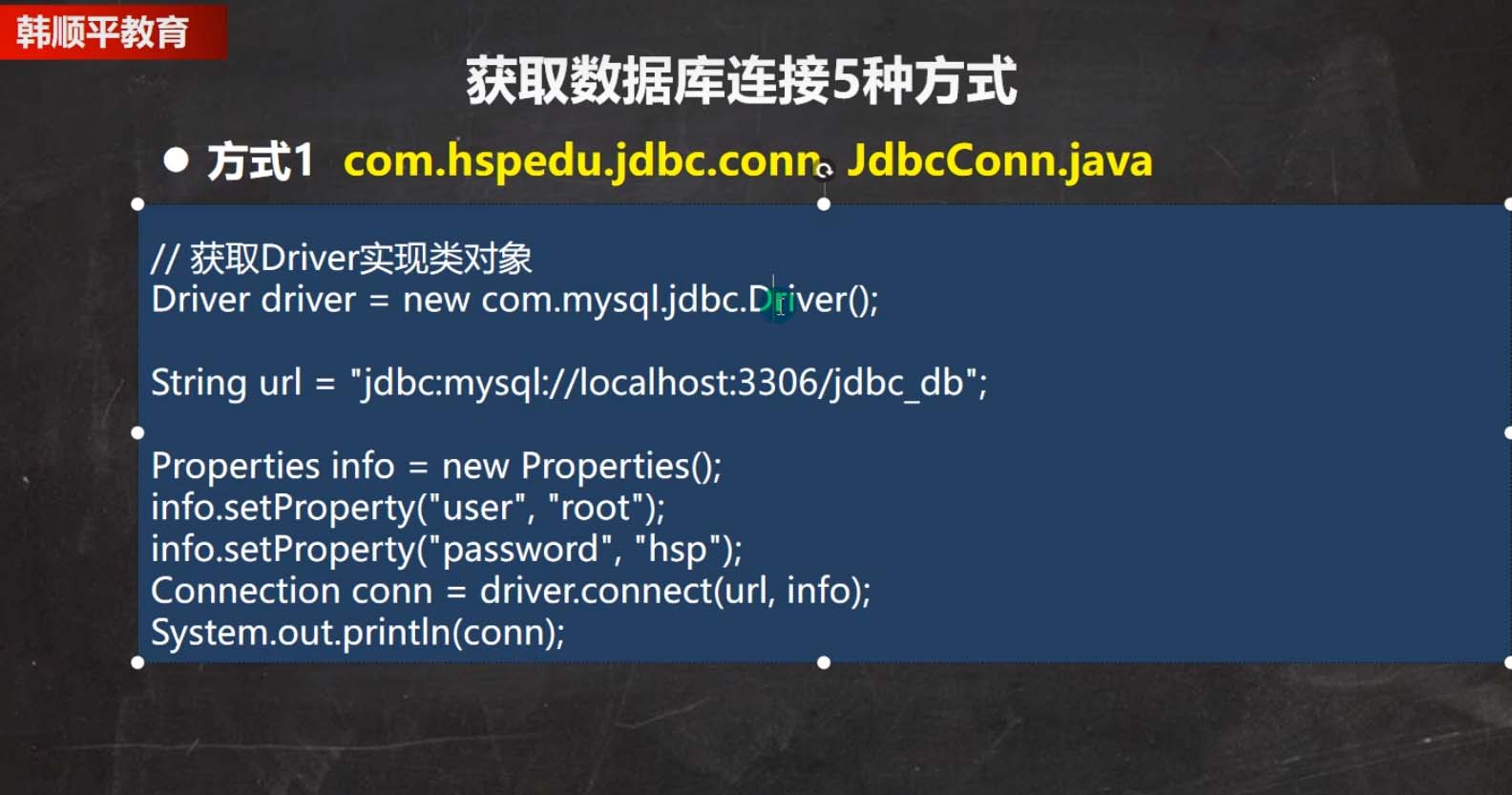
这种加载方式在jdbc入门时已经用过,这个driver属于第三方库,。为静态加载,灵活性差,依赖性抢
方式二:使用反射机制获取
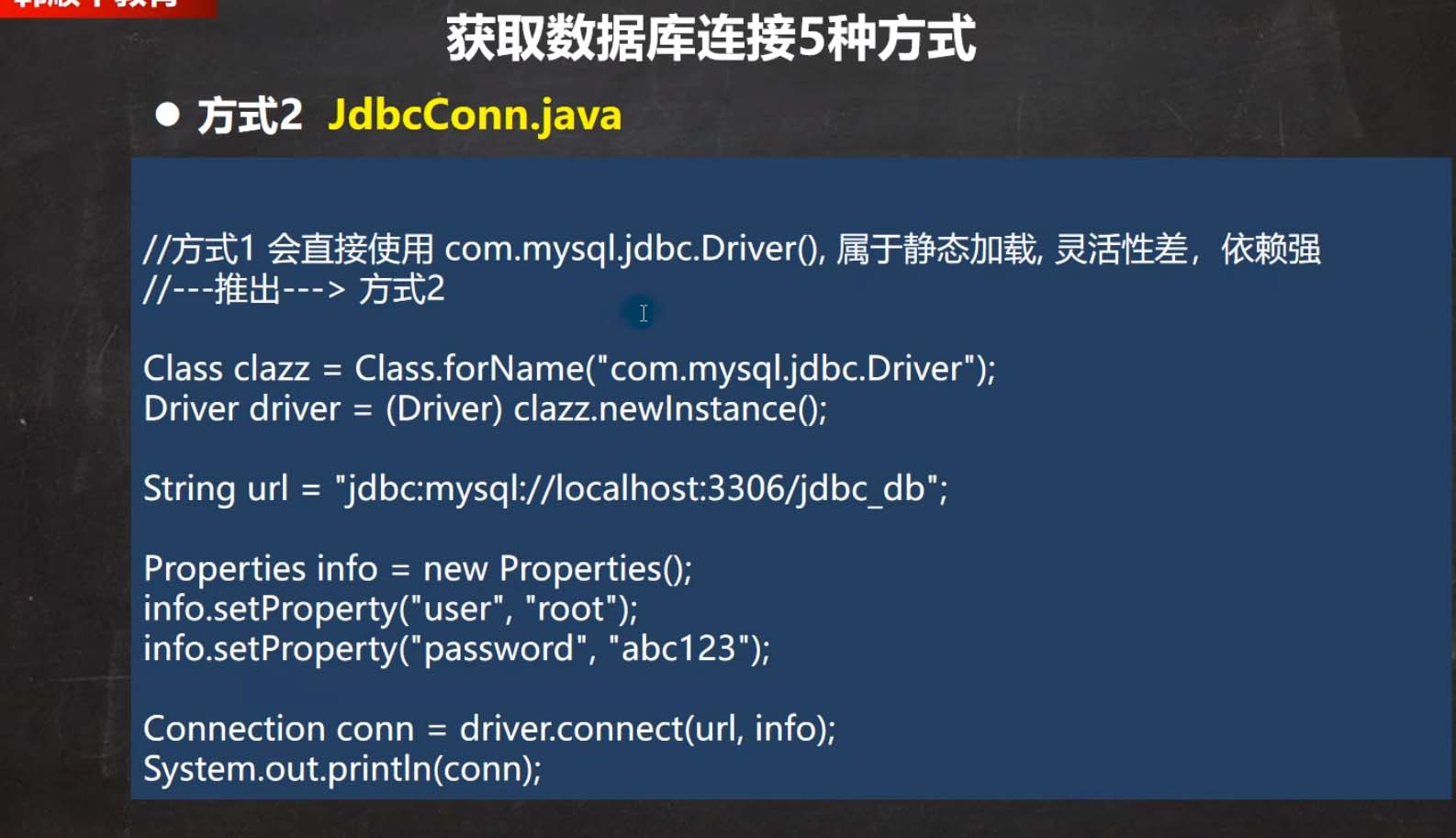
方式一和方式二代码
package com.hsp.edu;
import com.mysql.cj.jdbc.Driver;
import java.lang.reflect.Constructor;
import java.lang.reflect.InvocationTargetException;
import java.sql.Connection;
import java.sql.SQLException;
import java.util.Properties;
//java获取连接的5种方式
public class JdbcConnect {
public static void main(String[] args) throws SQLException, ClassNotFoundException, InstantiationException, IllegalAccessException, NoSuchMethodException, InvocationTargetException {
connect01();
connect02();
}
//方式一,直接导入第三方库驱动类
public static void connect01() throws SQLException {
//获取驱动
Driver driver = new Driver();
//获取连接
String url = "jdbc:mysql://localhost:3306/jdbc?serverTimezone=UTC&useSSL=false&useSer" +
"verPrepStmts=true&characterEncoding=utf-8&useSSL=false";
//将用户名和密码放入到Properities对象中
Properties properties = new Properties();
properties.setProperty("user","root");//用户
properties.setProperty("password","888888");//密码
final Connection connect = driver.connect(url, properties);
System.out.println(connect);
}
//方式二:使用反射加载Driver:动态加载,更加的灵活,减少依赖
public static void connect02() throws ClassNotFoundException, InstantiationException, IllegalAccessException, SQLException, NoSuchMethodException, InvocationTargetException {
//获取Driver类的字节码文件对象
final Class> clazz = Class.forName("com.mysql.cj.jdbc.Driver");
//注意:在用字节码文件对象获取Driver对象时,直接newInstance被idea提示已经弃用
final Constructor> Constructor = clazz.getDeclaredConstructor();
final Driver driver = (Driver)Constructor.newInstance();
String url = "jdbc:mysql://localhost:3306/jdbc?serverTimezone=UTC&useSSL=false&useSer" +
"verPrepStmts=true&characterEncoding=utf-8&useSSL=false";
//将用户名和密码放入到Properities对象中
Properties properties = new Properties();
properties.setProperty("user","root");//用户
properties.setProperty("password","888888");//密码
final Connection connect = driver.connect(url, properties);
System.out.println(connect);
}
}
方式三:使用DriverManager类

//方式三:使用DriverManager替换Driver
public static void connect03() throws SQLException, InvocationTargetException, InstantiationException, IllegalAccessException, NoSuchMethodException, ClassNotFoundException {
//DriverManager类支持更好的获取连接的方法,可以直接将用户和密码作为参数,而不用存储到Properities
final Class> clazz = Class.forName("com.mysql.cj.jdbc.Driver");
final Constructor> constructor = clazz.getDeclaredConstructor();
final Driver driver =(Driver)constructor.newInstance();
//创建url和user和password
String url = "jdbc:mysql://localhost:3306/jdbc?serverTimezone=UTC&useSSL=false&useSer" +
"verPrepStmts=true&characterEncoding=utf-8&useSSL=false";
String user = "root";
final String password = "888888";
DriverManager.registerDriver(driver);//注册Driver驱动
final Connection connection = DriverManager.getConnection(url, user, password);
System.out.println(connection);
}
方式四:在加载Driver类时自动完成驱动注册(以此简化代码)
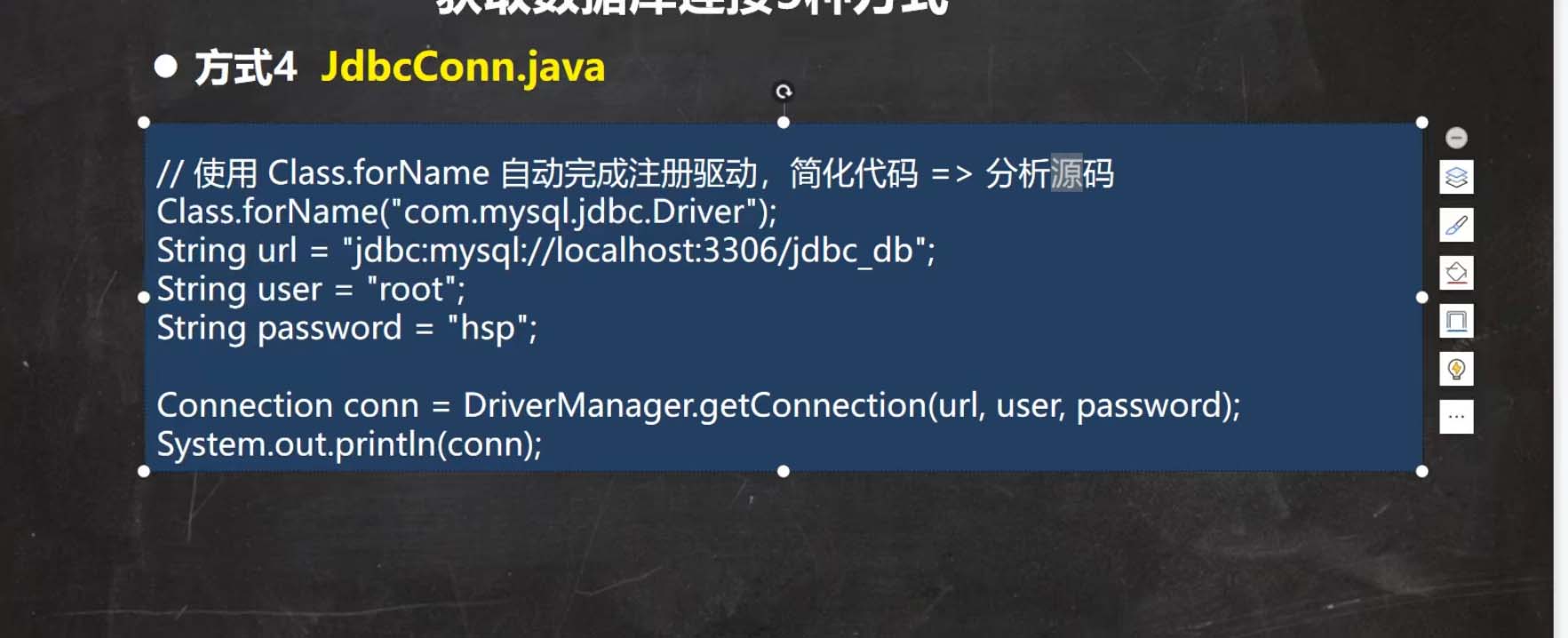
Driver类的底层源码
静态代码块:在类加载的时候会执行一次
从上面的Driver类的源码可以看出,在加载Driver类的时候,其静态代码块,已经完成了驱动的注册
//方式四:加载Driver时自动完成注册(这种方式使用的最多,推荐使用)
public static void connect04() throws ClassNotFoundException, SQLException {
//使用反射加载了Driver类
//在加载 Driver类时,完成注册
Class.forName("com.mysql.cj.jdbc.Driver");
String url = "jdbc:mysql://localhost:3306/jdbc?serverTimezone=UTC&useSSL=false&useSer" +
"verPrepStmts=true&characterEncoding=utf-8&useSSL=false";
String user = "root";
String password="888888";
final Connection connection = DriverManager.getConnection(url, user, password);
System.out.println(connection);
}
方式五:将信息写入到配置文件
一个疑问:为什么不写`Class.forName(“com.mysql.cj.jdbc.Driver”);也可以获取到连接?

在驱动文件中META-INF下面的services有个com.mysql.cj.jdbc.Driver文件里面已经记录了加载的全类名。
我们的程序将会直接按照文件中的内容进行加载
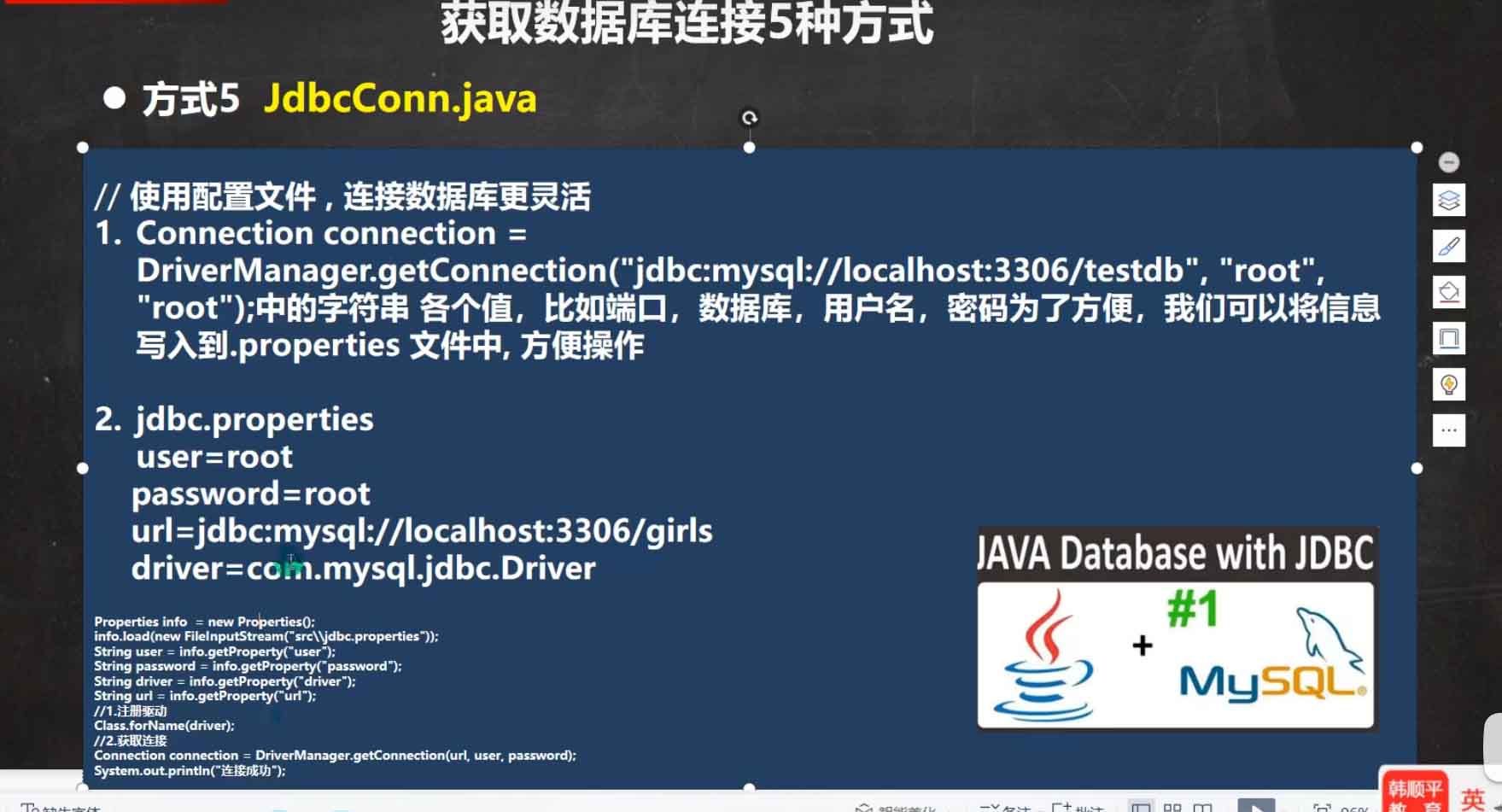
使用配置文件,当我们需要修改的时候就不用修改代码,只用修改配置文件即可
解惑:Properties类和properties文件没有直接关系(以前认为如果创建了一个properies文件,就已经存在了一个Properties对象)
Properties类只是和properties文件存储的格式一样(以键值对的形式存储),但是在使用的时候还是需要将文件中的数据读取到程序中 配置文件目录
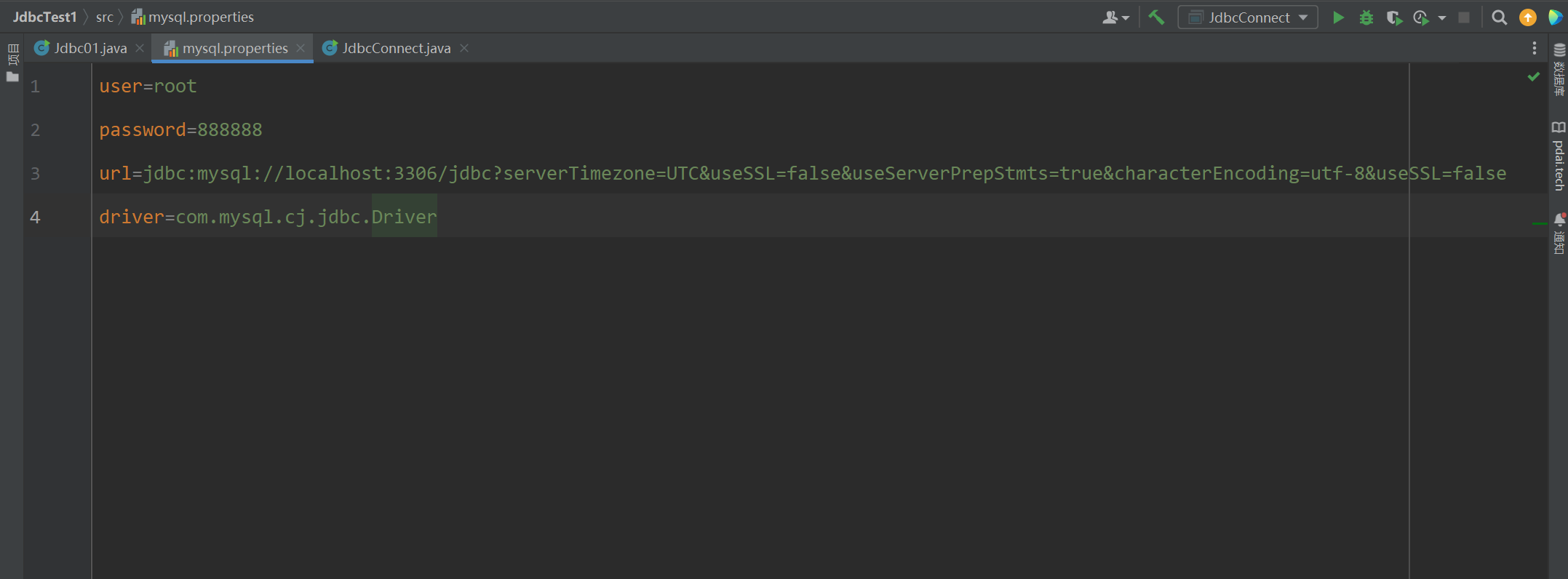
//方式五:进一步优化,将信息写入到配置文件
public static void connect05() throws IOException, ClassNotFoundException, SQLException {
//通过Properties对象获取配置文件信息
Properties properties = new Properties();
properties.load(new FileInputStream("src\mysql.properties"));//此时已经将配置文件的信息读取到了Properties中
//获取相关信息
final String user = properties.getProperty("user");//用户
final String password = properties.getProperty("password");//密码
final String url = properties.getProperty("url");//url
final String driver = properties.getProperty("driver");
Class.forName(driver);//注册驱动
final Connection connection = DriverManager.getConnection(url, user, password);//获取连接
System.out.println(connection);
}
课堂练习

属性文件

package com.hsp;
import java.io.FileInputStream;
import java.io.FileNotFoundException;
import java.io.IOException;
import java.sql.Connection;
import java.sql.DriverManager;
import java.sql.SQLException;
import java.sql.Statement;
import java.util.Properties;
/*
参考老师代码,使用方式5完成
1.创建news表
2.使用jdbc添加5条记录
3.修改id=1的记录content改成一个新的记录
*/
public class Jdbc02 {
public static void main(String[] args) throws IOException, ClassNotFoundException, SQLException {
//前置工作:获取配置文件中的信息
Properties properties = new Properties();
properties.load(new FileInputStream("src\mysql1.properties"));//读取信息到集合中
final String driver = properties.getProperty("driver");//获取全类名
final String url = properties.getProperty("url");//获取url
final String user = properties.getProperty("user");//获取用户名
final String password = properties.getProperty("password");//获取密码
System.out.println(properties);
//1.注册驱动
Class.forName(driver);
//2.获取连接
final Connection connection = DriverManager.getConnection(url, user, password);
//3.执行 SQL语句
//String sql1 = "CREATE TABLE news(id INT,content VARCHAR(32))";
String sql2="INSERT INTO news VALUES (1,'居民健康'),(2,'商品健康'),(3,'大熊猫')";
String sql3="UPDATE news SET content='湖北'WHERE id=1;";
final Statement statement = connection.createStatement();
//final int row1 = statement.executeUpdate(sql1);//返回影响的行数
final int row2 = statement.executeUpdate(sql2);//返回影响的行数
final int row3 = statement.executeUpdate(sql3);
//:验证是否执行成功
/*if(row1!=0){
System.out.println("执行成功");
}else {
System.out.println("执行失败");
}*/
if (row2!=0){
System.out.println("执行成功");
}else {
System.out.println("执行失败");
}
if(row3!=0){
System.out.println("执行成功");
}else {
System.out.println("执行失败");
}
//4.关闭资源
statement.close();
connection.close();
}
}
总结
以上为个人经验,希望能给大家一个参考,也希望大家多多支持IT俱乐部。

